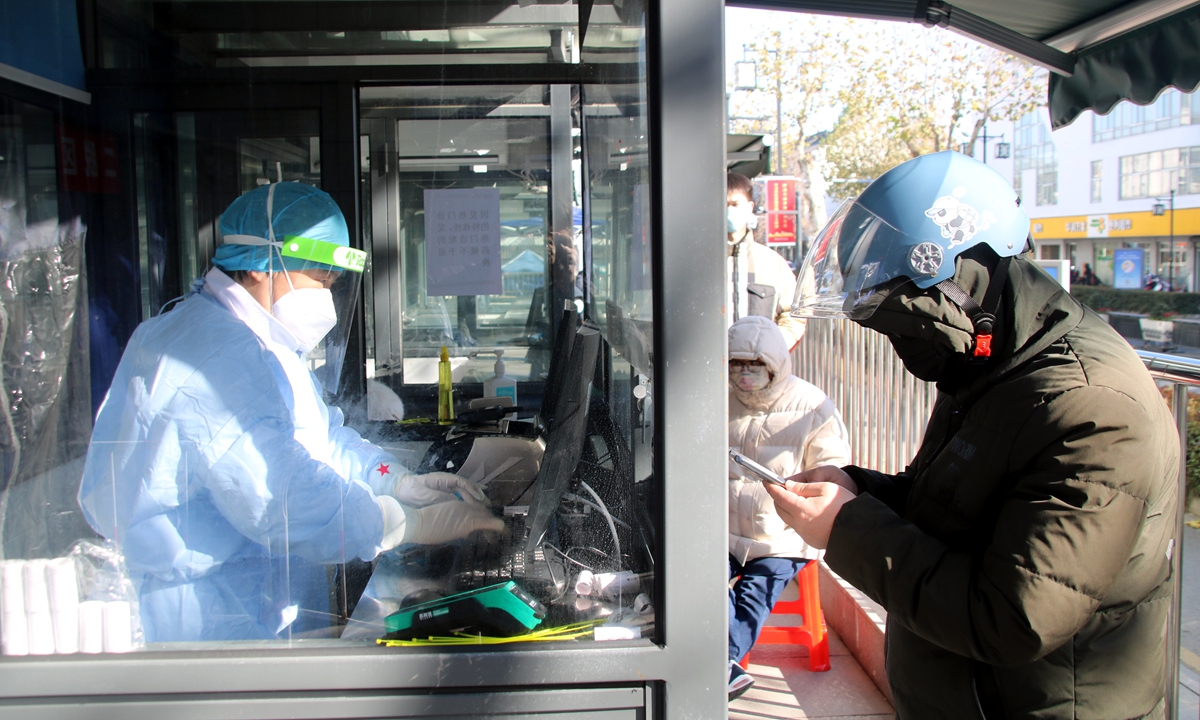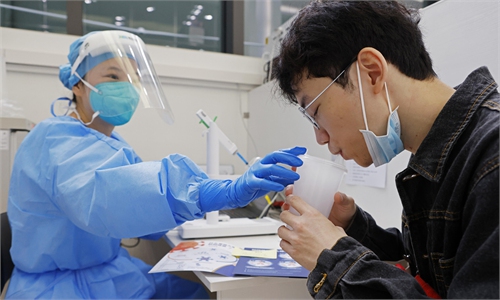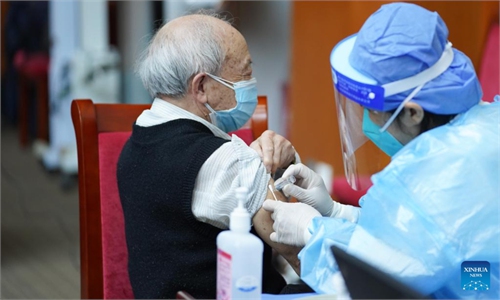Chinese hospitals expand ICUs, boost medical reserves to cope with COVID-19 surge
Lack of nursing staff for ICUs 'biggest challenge' for medical institutions: experts

A resident in Suzhou, East China's Jiangsu Province consults a doctor and buys medicine at a fever diagnosis and treatment station on December 18, 2022. The station was transformed from a nucleic acid sampling point. Photo: VCG
Chinese cities and medical institutions are ramping up efforts to expand intensive care units (ICUs) and boost their reserves of medical resources and treatment facilities for severe COVID-19 cases in a bid to strengthen medical treatment capabilities to cope with the COVID-19 peak.
Observers said that as the construction of more ICUs is underway, lack of fully trained medical staff for ICUs remains the biggest challenge for the medical institutions.
Media reports of emergency procurement of medical facilities for COVID-19 severe cases from hospitals have appeared more frequently in the past two weeks. For example, the People's Hospital in the Dazu district of Southwest China's Chongqing Municipality has budgeted 18.75 million yuan ($2.67 million) for this purpose and the hospital of traditional Chinese medicine in the Duzu district budgeted 15.93 million yuan for buying equipment to treat severe cases.
The People's Hospital in Caoxian county, East China's Shandong Province allocated 5 million yuan for facilities including ventilators. The People's Hospital in Dengfeng city of North China's Henan Province is scheduled to purchase medical cranes, invasive ventilators and extracorporeal membrane oxygenators (ECMO).
A medical staffer at a hospital in Shanghai told the Global Times that his hospital has enhanced its medicine reserves and has been communicating with drug companies for more fever and cough drugs.
Enhancing medical resources for severe cases has been one of the current primary targets of many city governments as well.
Guangzhou in South China's Guangdong Province is strengthening its medical resource reserves, improving medical capability in an all-round way including increasing the number of ICU beds from 455 to 1,385, to prepare for a predicted epidemic peak in early January 2023, a local health official said on Monday.
Since December, the number of fever outpatient visits in Guangzhou has continued to rise, and has remained at a high level for nearly a week. The majority of patients have been adults aged 18 to 59, accounting for 86 percent of the total, while the population aged 60 and above accounted for 8.2 percent, and individuals under the age of 18 accounting for 5.8 percent, Zhang Yi, deputy director of the municipal health commission of Guangzhou, said at a Monday press briefing.
East China's Zhejiang Province has mobilized efforts to ensure there are no less than 100,000 beds across the province and ICU beds in general hospitals account for no less than 4 percent of the total beds by the end of December. Besides, at least another 4 percent of the total beds should be ready for use as ICU beds to meet the needs of severe treatment to the greatest extent.
Medical pressure has been felt among hospitals at all levels across the country since China opted to optimize its COVID-19 response. But so far hospitals can still withstand the COVID-19 shock, Zhang Yuexin, an expert on epidemic prevention and control, told the Global Times on Monday.
In the past three years, health authorities have been making efforts to strengthen medical resources among hospitals and the construction of ICUs. The process has only been speeding up dynamically based on current needs, Zhang noted.
Following the requirement of the National Health Commission, designated hospitals should be equipped with enough beds for treatment according to the size of the local population, and ICU beds should account for 10 percent of the total number of beds. "Now county-level designated hospitals have made such preparations, even some makeshift hospitals are making these preparations based on this standard," Zhang said.
Zhang pointed out the current shortage is the lack of nursing staff for ICUs. Many hospitals are relying on borrowing staff from other institutions and some are urgently training medical staff and nursing staff for ICUs.
The ICU requires a high number of competent nursing staff. The people's hospitals of Chinese cities are better off in nursing resources but other hospitals are less capable to recruit and train physicians and nurses, Liu Xiaojun, an ICU director of the Second Affiliated Hospital of Zhengzhou University, Henan Province, told Chinese media.
South China's Hainan Province, for example, is scheduled to train 1,832 intensive care physicians and 5,481 nurses who staff the unit, besides the current 209 intensive care physicians and 642 nurses. Data showed the total number of ICUs across Hainan is 1,013 and another 1,114 are under construction.
Zhang also noted that compared with other countries, medical resources across China are distributed unevenly, with huge gaps between urban areas and rural areas. The US has 34.7 ICU beds per 100,000 people, and Germany came second, with 29.2 ICU beds per 100,000 people, media reported.
At present, the total number of ICU beds in China has reached 138,100, close to the level of 10 beds for every 100,000 people, latest data provided by the NHC on December 9 showed.
The total number of registered physicians in ICUs stands at 80,500 and more than 106,000 can be "converted" into physicians working in ICUs. The number of nurses in ICUs is 220,000, and 177,700 nurses can be converted to work in ICUs.
China is expected to record more than 124 million COVID-19 cases with symptoms and 2.7 million are in need of ICUs, the experts team led by Yu Hongjie from the School of Public Health, Fudan University predicted, based on the vaccination rate of the country in March 2022, when some 124 million people, about 80 percent of the total population, were fully vaccinated.
The prediction showed the demand for ICU beds would reach 1 million at most, over 15 times the current capacity.
But some other calculations are a lot more optimistic. Yixuejie, a leading platform for medical insights and information in China, quoted an anonymous expert as saying that cases that require ICU beds and general inpatient beds accounted for about 0.1 percent and 10 percent of the total number of infections, respectively.
Leading Chinese epidemiologists are optimistic that the epidemic situation will improve by spring next year and will enter a normal status after the epidemic peaks in January and February.


